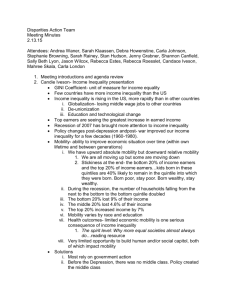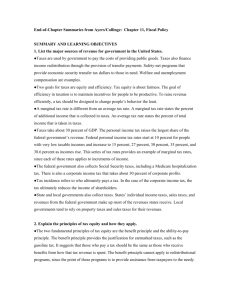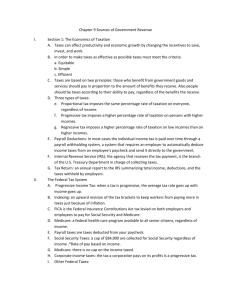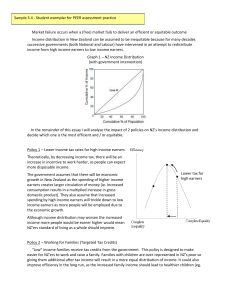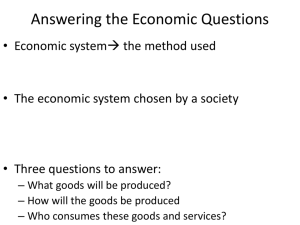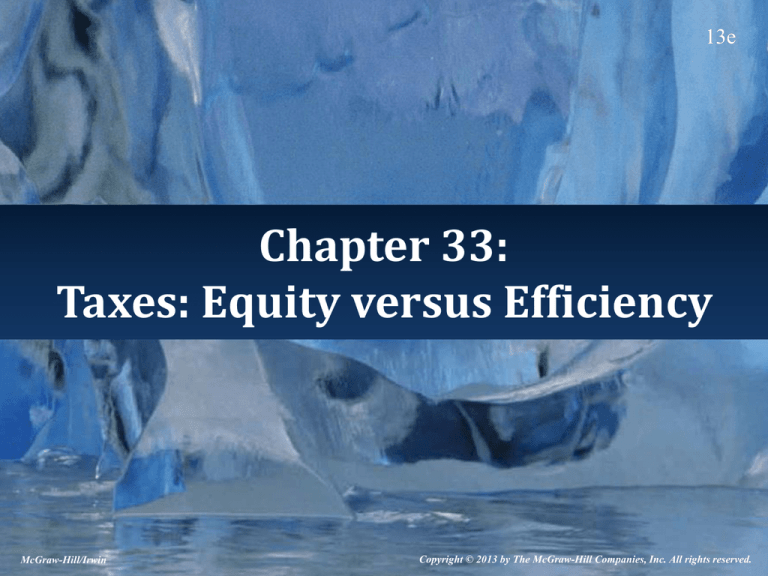
13e
Chapter 33:
Taxes: Equity versus Efficiency
McGraw-Hill/Irwin
Copyright © 2013 by The McGraw-Hill Companies, Inc. All rights reserved.
Distribution
• Once goods are produced, the FOR WHOM
question must be answered.
– Should the market decide?
– Should government intervene?
• The market would strive for efficiency and
reward producers according to their value
in production.
• The government would strive for greater
equity – that is, a more equal distribution.
33-2
Distribution
• Some participants in the market are wildly
successful and earn millions. Others are
unsuccessful and must go without many
amenities.
– The market generates inequalities in income
distribution.
– Should the government intervene to
redistribute some income?
– If so, how should it do that?
33-3
Distribution
• The tax system is the government’s main
lever to redistribute income.
• Taxes affect both production and
distribution.
• There is a potential trade-off between
equity and efficiency.
33-4
Learning Objectives
• 33-01. Know how the U.S. tax system is
structured.
• 33-02. Know what makes taxes more or less
progressive.
• 33-03. Know the nature of the equityefficiency trade-off.
33-5
What Is Income?
• Personal income is the amount earned and
received by households before taxes are
paid.
• Some households get in-kind income: goods
and services received directly (not via a
market transaction).
• Measuring income by different means
causes some distortions in year-to-year
comparisons.
33-6
What Is Income?
• A family is declared to be “poor” if their
money income is below a certain threshold.
– Counting this way, there has been no progress
in the War on Poverty since it started in 1965.
– There are more “poor” today than in 1965.
• If we add in-kind income, there are fewer
“poor” today than in 1965, indicating
modest progress.
33-7
What Is Income?
• We also must consider the distribution of
wealth (the market value of assets owned).
– Wealth is a stock of potential purchasing power.
– Wealth tends to be distributed less equally than
income.
33-8
The Distribution of Income
• We divide households
into quintiles (fifths or
20% of households)
according to their
income.
• The bowed Lorenz
curve shows that the
income share of the
lowest fifth is 3.4%
and the top fifth has
half of the total
income.
33-9
The Distribution of Income
• The diagonal line
shows what the
distribution would be
if there were complete
equality.
– 20% of households
would receive 20% of
income.
• The greater the area
between the Lorenz
curve and the
diagonal, the more
inequality exists.
33-10
The Distribution of Income
• The area under the diagonal of the Lorenz
curve is represented by the Gini coefficient.
– The higher the Gini coefficient, the greater the
inequality of income.
• Large inequality, to some, represents market
failure.
– Income distribution is “unfair.”
– The government should intervene by levying taxes
on the “rich” and making transfer payments to the
“poor.”
33-11
The Federal Income Tax
• Efficiency concerns.
• The federal income tax is progressive.
– It imposes higher tax rates on high incomes than on
low incomes.
– The marginal tax rate increases as incomes rise.
• Marginal tax rate: the tax rate imposed on the last
(marginal) dollar of income.
– Higher-income earners find themselves in higher tax
brackets.
• The goal of progressive tax rates is to reduce
inequality.
33-12
The Federal Income Tax
• Efficiency concerns.
– Progressive taxes reduce inequality but also
affect efficiency.
– Since marginal tax rates increase as income
increases, the progressive tax system punishes
success.
• It is a disincentive to work more, produce more, or
invest more.
– The implication is that rising marginal tax rates
can contribute to a decrease in total output.
33-13
The Federal Income Tax
• Equity concerns.
– In theory, a progressive tax system taxes the
“rich” heavily and distributes the proceeds to
the “poor.”
– In reality, the system is not so progressive.
– The tax code applies only to “taxable” income,
not all income. To arrive at taxable income,
deduct all
• Exemptions.
• Itemized deductions.
• Other tax breaks in the tax code (“loopholes”).
33-14
The Federal Income Tax
• Equity concerns.
– As a result, many high-income earners can
reduce their taxable income greatly and pay
little tax.
• Some pay less tax than people with lower incomes.
• The bulk of taxes are paid by the “middle class,” not
the “rich.”
– There are two equity considerations:
• Vertical equity: people with higher incomes should
pay more taxes than people with lower incomes.
• Horizontal equity: people with equal incomes should
pay equal taxes.
33-15
The Federal Income Tax
• Equity concerns.
– As a result of loopholes, there is a distinction
between nominal tax rates and effective tax
rates.
• Nominal tax rate: taxes paid divided by taxable
income.
• Effective tax rate: taxes paid divided by total income.
– The gap between nominal and effective tax rates
reflects the loopholes in the tax code.
33-16
The Federal Income Tax
• Resource misallocations.
– Tax loopholes alter the mix of outputs.
– Tax-preferred activities receive more resources,
and heavily taxed activities receive fewer
resources.
– The resulting mix of output could be inferior to
the mix that a pure market outcome would
generate, and therefore could be characterized
as government failure.
33-17
The Federal Income Tax
• A shrinking tax base.
– Loopholes shrink the tax base.
– As the base of taxable income shrinks, the
average tax rate must increase to maintain the
same tax revenue.
Tax revenue = Average tax rate X Tax base
33-18
Payroll, State, and Local Taxes
• Sales and property taxes.
– These are major sources of revenue for state
and local government.
– Both taxes are regressive because the tax rate
falls as income rises.
– This imposes a proportionally larger burden of
the tax on lower-income earners.
33-19
Payroll, State, and Local Taxes
• Sales and property taxes.
– Tax incidence: where the real burden of a tax
falls.
– Sales tax incidence:
• At lower incomes, earners spend all of their
income, which is subject to sales tax.
• At higher incomes, earners do not pay sales
tax on income not spent, but saved.
33-20
Payroll, State, and Local Taxes
• Sales and property taxes.
– Property tax incidence:
• Income going to housing is higher for lowincome earners, who primarily rent rather
than own.
• Property tax is reflected in higher rents.
33-21
Payroll, State, and Local Taxes
• Payroll taxes.
– Social Security payroll tax is the second-largest
source of federal tax revenue.
– Workers pay this tax on earnings up to
$106,800.
– Thus the tax is regressive. Higher-income
earners pay no tax on income above that level.
– Half of the tax is paid by employers. This is an
added business cost, which is a disincentive to
hire.
33-22
Taxes and Inequality
• Despite rampant
loopholes, the income
tax system ends up
being progressive.
• Note that the top 50%
earn 88% of income
and pay 97% of taxes,
while the bottom 50%
earn 12% of income
and pay 3% of taxes.
33-23
Taxes and Inequality
• When state and local taxes are taken into
account, however, the tax system as a whole
ends up being nearly proportional.
– Proportional tax system: the percentage of income
going to taxes is the same no matter what the
income.
• The redistribution process is completed by the
government transferring income to favored
segments of society. We will look at this in the
next chapter.
33-24
What Is Fair?
• Everyone has an opinion about how to answer
this question.
• Costs of greater equality.
– Incentives to work hard are reduced.
– The willingness to produce is reduced.
– The link between effort and reward is weakened.
• The argument for preserving some inequity is
to maintain productivity.
• There is a trade-off between efficiency and
equality.
33-25
What Is Fair?
• There is a trade-off between efficiency and
equality.
• The benefits of greater equality.
– Low-income earners might work harder if incomes
were more fairly distributed.
– Low incomes subject their earners to poor health,
malnutrition, and inadequate educational
opportunities.
– Loopholes distort economic incentives. Simplify the
tax code and resources would be more efficiently
allocated.
33-26

